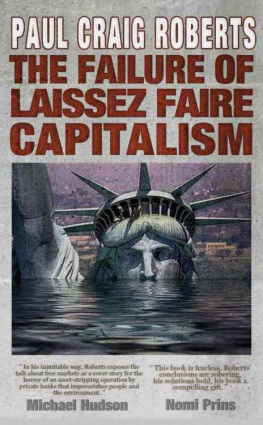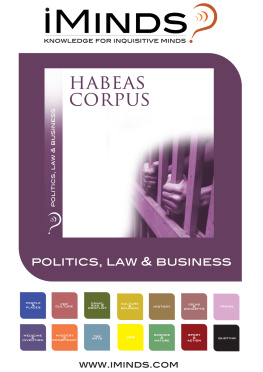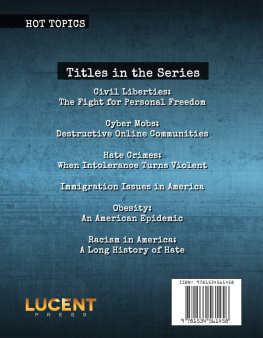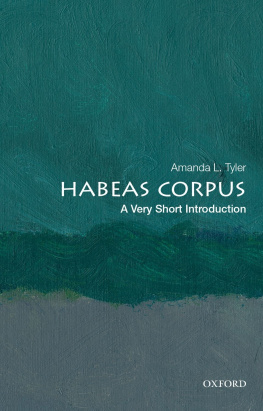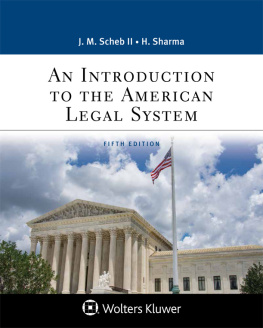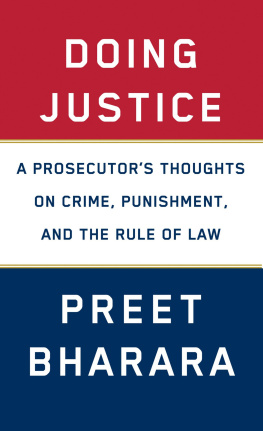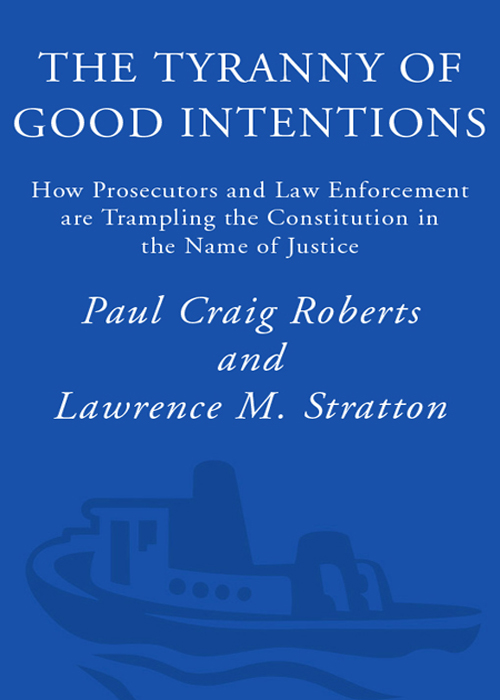
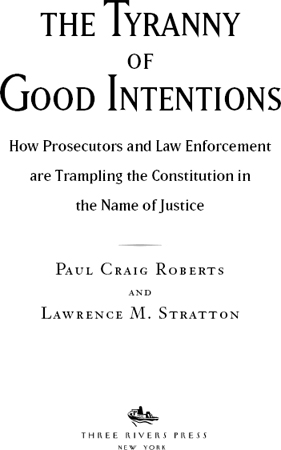
CONTENTS
For Dean Booth and Harvey Silverglate
AUTHORS NOTE
SINCE THIS BOOK was first published, the Microsoft case (chapter 12) has been resolved. An appellate court overturned Federal District Judge Thomas Penfield Jacksons draconian order that Microsoft be broken into pieces. The appellate court assailed Jackson for his repeated, egregious, and flagrant anti-Microsoft ex parte comments to reporters during the trial. Appellate Judge Colleen Kollar-Kotelly instructed Microsoft and the Justice Department to settle the case in light of the tragic events affecting our nation (9/11).
Microsoft essentially prevailed with a court-approved settlement in which Microsoft agreed to share some of its Windows code with competitors, adjust some of its dealings with other tech companies, and be monitored by a compliance committee. What had been hyped as the antitrust case of the century ended with a whimper. Nevertheless, Microsoft has not recovered its high-tech edge lost to the diversion of a decade of its energy to the prevention of its frame-up by assistant attorney general Joel I. Klein, legal trickster David Boies, and co-opted judge Penfield Jackson. When a high-tech leader loses its edge, so does a countrys economy. The egos of Klein, Boies, and Jackson extracted a price from every American.
Jesse Trentadue, the attorney brother of Kenneth Trentadue, who was murdered in a case of mistaken identity by a federal goon squad in a federal prison (see chapter 10), is still being stonewalled by the DOJ.
Regarding forfeiture (chapter 9), property is less secure today than when this book was first published. In 2000, Congress passed a weak reform statute, which changed some burdens of proof and gave poor victims of the new robber barons access to lawyers. The bad press that House Judiciary Committee Chairman Henry Hyde gave forfeiture dampened some of the worst abuses. However, the war on terror has breathed new life into forfeiture with the theft of assets of Muslim charities and of companies and individuals, such as medical doctors, accused (without evidence) of benefiting terrorists under the guise of providing aid to injured children and displaced persons. On July 17, 2007, President Bush signed an executive order permitting the confiscation without notice of the property of individuals, groups, or businesses deemed to pose a significant risk of committing an act threatening the peace and stability of Iraq. The power of the U.S. government to confiscate on the assumption that a person or group might commit an infraction in the future is a perfect example of Benthamite law. Benthamite law is incompatible with the U.S. Constitution.
To clarify, our criticism in chapter 12 of the constitutional law textbook by Farber, Eskridge, and Frickey is directed at the insouciance of legal scholars to Blackstones Rights of Englishmen, and our exposition of the ethics of J. Edgar Hoovers FBI are intended as a contrast with the situation today.
The rest of the book remains as it was written, a factual reporting of legal cases and prosecutorial misbehavior that have eroded the legal principles that the Founding Fathers placed in the U.S. Constitution to protect the American people from arbitrary and unaccountable power.
ACKNOWLEDGMENTS
AUTHORS HAVE MANY people to whom they owe thanks: families, friends, colleagues, teachers, editors, and copyeditors. We owe thanks to all of these. We also owe thanks to the trustees, donors, and advisors of the Institute for Political Economy, a nonprofit research institute that made this book possible.
We wish to express our appreciation to the Independent Institute for its help in bringing this book to the attention of jurists and legal scholars. The Independent Institute (www.independent.org), located at 100 Swan Way, Oakland, CA 94621 (510-632-1366), is a nonprofit research and educational organization that supports independent research. With 130 affiliated research fellows, books, conferences, and a quarterly journal, the Independent Institute clarifies public issues and advances the frontiers of knowledge.
P.C.R. L.M.S.
INTRODUCTION TO THE PAPERBACK EDITION
SINCE THIS BOOK was first published in 2000, the erosion of the legal principles that protect the innocent has continued apace. One could even say that the U.S. criminal justice system is no longer concerned with innocence or guilt, only with ruining as many people as quickly as possible in order to justify budgets and political ambitions with high conviction rates.
As we sit writing this Memorial Day weekend, the front-page headline of the Atlanta Journal-Constitution (May 26, 2007) is Rogue Cop Cases. The newspaper reports: Fulton County District Attorney Paul Howard said Friday that four men should be released from prison because their drug convictions were based on the work of Atlanta cops who have admitted lying to make cases, including one that left a 92-year-old woman dead in a botched raid. Forty-one other Atlanta cases have been put on hold subject to reinvestigation. In truth, the reinvestigation will be the first investigation. The first time, the cases were processed rather than investigated.
The cops framed victims have already served most of their prison sentences. Defense attorney Steve Sadow said that it is an outrage that a dysfunctional criminal justice system is permitted to steal years from peoples lives by falsifying evidence and framing innocent people. Sadow asked, Where are the checks and balances in the system?
The answer to Sadows question is that there are hardly any checks and balances left in the system, other than a few overburdened law school innocence projects working to free the most obviously wrongfully convicted and an occasional idealistic district attorney, such as Paul Howard and Craig Watkins (see chapter 13), who have seen enough injustice to have no illusions about the system.
Except for experienced defense lawyers and inner-city blacks, most Americans believe that the problem with the criminal justice system is that liberal judges turn loose criminals to prey on society. They regard the wrongful convictions (an euphemism for what are in many cases unlawful convictions) that come to light as aberrations and honest mistakes, the correction of which proves that the criminal justice system works. Most Americans know nothing of the large numbers of wrongful and unlawful convictions that are not corrected. Few Americans are aware of the real failings of the justice system. Their misplaced concern is that too many who are guilty escape conviction.
Best-selling author John Grishams first work of nonfiction, The Innocent Man (2006), helps to correct the publics misperception, as does Actual Innocence (2000) by Barry Scheck, Peter Neufield, and Jim Dwyer. Recent research findings also reveal that the innocent bear a large burden of the justice systems failures. For example, on June 28, 2007, Breitbart.com reported research by Northwestern University professor Bruce Spencer, who examined 290 noncapital criminal cases in 4 major cities from 2000 to 2001. Spencer discovered that innocent defendants had a 25 percent chance of being wrongfully convicted by juries and a 37 percent chance of being wrongfully convicted by a judge. In contrast, Spencer found only a 10 percent chance that a jury would acquit a guilty person and a 13 percent chance that a judge would acquit a guilty person. According to Northwestern University law professor Jack Heinz, the concentration of errors in wrongful conviction results from the strong presumption of guilt when someone is arrested and brought to trial.
Next page

